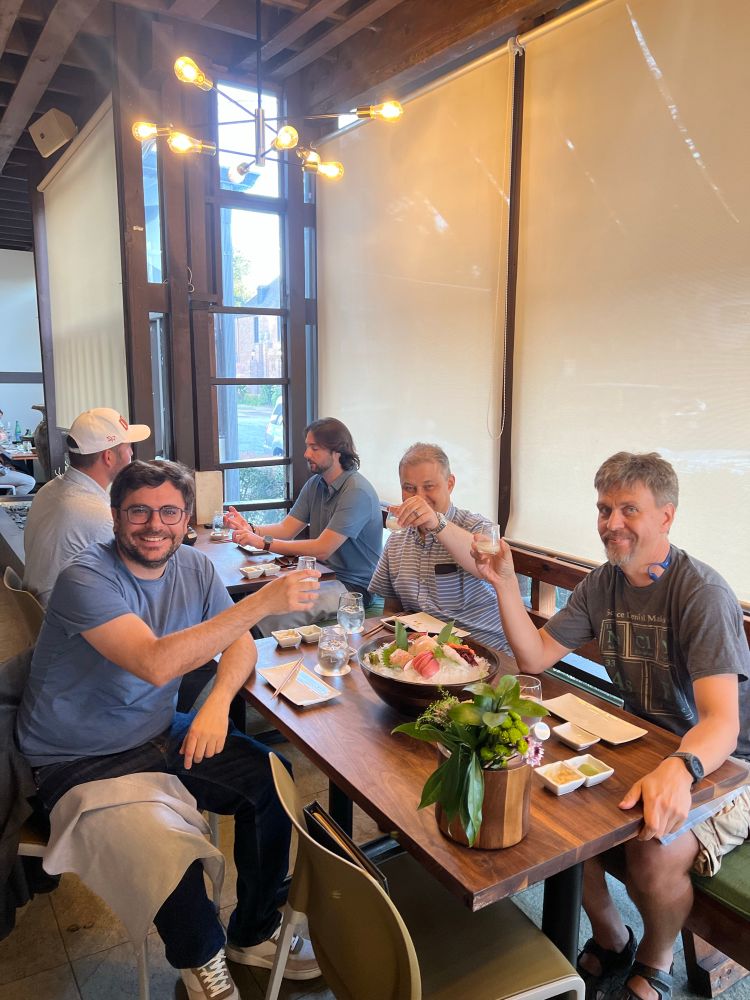Hopefully high SNR messaging from this account about low SNR data :)
#science #machinelearning #datamodeling
If interested, please apply. Feel free to contact me with any questions.
We are seeking, first and foremost, a leader & world-class scientist with a strong research record
apply.interfolio.com/176489
#asu #ASUResearch
If interested, please apply. Feel free to contact me with any questions.
We are seeking, first and foremost, a leader & world-class scientist with a strong research record
apply.interfolio.com/176489
#asu #ASUResearch
We will miss you Weiqing!

We will miss you Weiqing!
Weiqing’s thesis intro on tracking was so beautiful we turned it into a perspective in JCP who then selected it as a #Scilight.
Take a look! 😊
www.aip.org/scilights/tr...

Weiqing’s thesis intro on tracking was so beautiful we turned it into a perspective in JCP who then selected it as a #Scilight.
Take a look! 😊
www.aip.org/scilights/tr...
A testament to the great people we work with (and the unwavering rigor of Bayesian approaches, impervious to hype) 😊 🙏
news.asu.edu/b/20251021-a...
A testament to the great people we work with (and the unwavering rigor of Bayesian approaches, impervious to hype) 😊 🙏
news.asu.edu/b/20251021-a...
🙏 our lab members and collaborators.
Citation: “For pioneering contributions to Bayesian method development in biological physics, particularly […] to imaging and single-molecule experiments.
#APSFellow
🙏 our lab members and collaborators.
Citation: “For pioneering contributions to Bayesian method development in biological physics, particularly […] to imaging and single-molecule experiments.
#APSFellow
(Discussing Bach, Richter, Gould, Yuja Wang, and maybe some single molecule 😊)

(Discussing Bach, Richter, Gould, Yuja Wang, and maybe some single molecule 😊)
Joining me are Tolya Kolomeisky and Oleg Igoshin.

Joining me are Tolya Kolomeisky and Oleg Igoshin.
Tomorrow I’ll be giving a chalk talk on our new eLife:
“REPOP: bacterial population quantification from plate counts”
elifesciences.org/reviewed-pre...
Looking forward to seeing you!!
#eLife #datascience #biophysics #bioinformatics #Bayesian #REPOP

Tomorrow I’ll be giving a chalk talk on our new eLife:
“REPOP: bacterial population quantification from plate counts”
elifesciences.org/reviewed-pre...
Looking forward to seeing you!!
#eLife #datascience #biophysics #bioinformatics #Bayesian #REPOP
Not really 😢
Emission noise accounts for ~99% of the likelihood.
TLDR: What you think is anomalous diffusion… might just be noise. 🤷♂️🤷♂️🤷♂️🤷♂️
🔗 Read more in our latest preprint: arxiv.org/abs/2507.05599
#Biophysics

Not really 😢
Emission noise accounts for ~99% of the likelihood.
TLDR: What you think is anomalous diffusion… might just be noise. 🤷♂️🤷♂️🤷♂️🤷♂️
🔗 Read more in our latest preprint: arxiv.org/abs/2507.05599
#Biophysics
If you do #PlateCounting, you may want to take a look at our new eLife @elife.bsky.social
If you don't, I still encourage you to join for an interesting discussion.
Follow the thread 🧵
elifesciences.org/reviewed-pre...
#Microbiology #DataScience #PyTorch #QuantitativeBiology #REPOP
If you do #PlateCounting, you may want to take a look at our new eLife @elife.bsky.social
If you don't, I still encourage you to join for an interesting discussion.
Follow the thread 🧵
elifesciences.org/reviewed-pre...
#Microbiology #DataScience #PyTorch #QuantitativeBiology #REPOP
Does the results seems contradictory?
If so, you are going to love our new preprint:
arxiv.org/abs/2506.05707

Does the results seems contradictory?
If so, you are going to love our new preprint:
arxiv.org/abs/2506.05707
🎧 There's an AI-generated podcast of my #TimeSeriesForecasting paper 🤔🤔
www.youtube.com/watch?v=3BNz...
Not sure whether to feel flattered, creeped out, or alarmed.
That is the future I guess 🤷♂️🤷♂️
To read the full paper: doi.org/10.1088/2632...

🎧 There's an AI-generated podcast of my #TimeSeriesForecasting paper 🤔🤔
www.youtube.com/watch?v=3BNz...
Not sure whether to feel flattered, creeped out, or alarmed.
That is the future I guess 🤷♂️🤷♂️
To read the full paper: doi.org/10.1088/2632...
Hopefully high SNR messaging from this account about low SNR data :)
#science #machinelearning #datamodeling
Hopefully high SNR messaging from this account about low SNR data :)
#science #machinelearning #datamodeling

